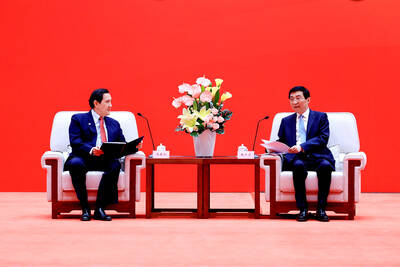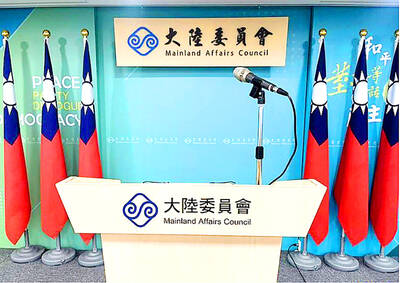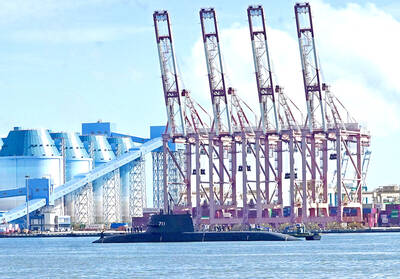Oil prices leapt above US$106 in New York on Friday as investor sentiment was driven by the weak US dollar, tight energy supplies and more bad news on the US economy.
New York’s main oil contract, light sweet crude for delivery in May, jumped US$2.40 to close at US$106.23 per barrel.
London’s Brent North Sea crude for May rallied US$2.38 to US$104.90 at the settlement.
“Crude futures were higher as the dollar weakened,” Sucden analyst Nimit Khamar said in London. The weak US currency tends to encourage demand for dollar-priced crude because it becomes cheaper for foreign buyers.
The dollar sank further against the euro on Friday after news that US employers cut a surprisingly large 80,000 jobs last month, the biggest decline in employment in five years, according to a government report.
The mounting job losses swelled the US unemployment rate to 5.1 percent last month, compared with 4.8 percent in February.
Last month’s nonfarm job losses marked the sharpest monthly decline since March 2003 and the start of the Iraq war, while the unemployment rate leapt to its highest level since September 2005.
Friday’s jobs report prompted many commodity fund investors to bet on fresh falls for the dollar, traders said.
“Commodity funds are in many ways ahead of the dollar,” Alaron Trading analyst Phil Flynn said. “The bad jobs number is basically reinforcing the idea that the [US] interest rates will come down.”
“Bad economic news is good for commodities” in the near term, Flynn said.
Mike Fitzpatrick at MF Global said that despite the speculative push, the trend should be lower for oil futures since slower economic growth will mean softer demand.
“Uncertainty over future demand has undermined every rally recently, and if the jobs number is any measure of the pulse of the economy, it certainly has to be disappointing relative to energy demand growth, particularly when coupled with the jump in crude oil stocks recently,” he said. “With stocks building and demand slipping, it is difficult to justify prices at current levels. Technically, the market’s upward momentum seems to be fading ... The US is not alone in experiencing a creeping economic malaise.”
This week, the oil market was gripped by volatility as traders weighed the likely slowing of global economic growth against concerns about tight energy supplies.
Many traders are concerned that slowing US growth could prompt a slowdown in demand.
On Wednesday, however, prices soared after news that US gasoline reserves tumbled 4.5 million barrels, compared with forecasts for a smaller drop of 2.5 million barrels.
The market is beginning to closely watch gasoline inventories ahead of the US peak demand season for motor fuel, which begins next month when Americans begin their summer vacations.

CHIP WAR: The new restrictions are expected to cut off China’s access to Taiwan’s technologies, materials and equipment essential to building AI semiconductors Taiwan has blacklisted Huawei Technologies Co (華為) and Semiconductor Manufacturing International Corp (SMIC, 中芯), dealing another major blow to the two companies spearheading China’s efforts to develop cutting-edge artificial intelligence (AI) chip technologies. The Ministry of Economic Affairs’ International Trade Administration has included Huawei, SMIC and several of their subsidiaries in an update of its so-called strategic high-tech commodities entity list, the latest version on its Web site showed on Saturday. It did not publicly announce the change. Other entities on the list include organizations such as the Taliban and al-Qaeda, as well as companies in China, Iran and elsewhere. Local companies need

CRITICISM: It is generally accepted that the Straits Forum is a CCP ‘united front’ platform, and anyone attending should maintain Taiwan’s dignity, the council said The Mainland Affairs Council (MAC) yesterday said it deeply regrets that former president Ma Ying-jeou (馬英九) echoed the Chinese Communist Party’s (CCP) “one China” principle and “united front” tactics by telling the Straits Forum that Taiwanese yearn for both sides of the Taiwan Strait to move toward “peace” and “integration.” The 17th annual Straits Forum yesterday opened in Xiamen, China, and while the Chinese Nationalist Party’s (KMT) local government heads were absent for the first time in 17 years, Ma attended the forum as “former KMT chairperson” and met with Chinese People’s Political Consultative Conference Chairman Wang Huning (王滬寧). Wang

CROSS-STRAIT: The MAC said it barred the Chinese officials from attending an event, because they failed to provide guarantees that Taiwan would be treated with respect The Mainland Affairs Council (MAC) on Friday night defended its decision to bar Chinese officials and tourism representatives from attending a tourism event in Taipei next month, citing the unsafe conditions for Taiwanese in China. The Taipei International Summer Travel Expo, organized by the Taiwan Tourism Exchange Association, is to run from July 18 to 21. China’s Taiwan Affairs Office spokeswoman Zhu Fenglian (朱鳳蓮) on Friday said that representatives from China’s travel industry were excluded from the expo. The Democratic Progressive Party government is obstructing cross-strait tourism exchange in a vain attempt to ignore the mainstream support for peaceful development

DEFENSE: The US would assist Taiwan in developing a new command and control system, and it would be based on the US-made Link-22, a senior official said The Ministry of National Defense is to propose a special budget to replace the military’s currently fielded command and control system, bolster defensive resilience and acquire more attack drones, a senior defense official said yesterday. The budget would be presented to the legislature in August, the source said on condition of anonymity. Taiwan’s decade-old Syun An (迅安, “Swift Security”) command and control system is a derivative of Lockheed Martin’s Link-16 developed under Washington’s auspices, they said. The Syun An system is difficult to operate, increasingly obsolete and has unresolved problems related to integrating disparate tactical data across the three branches of the military,